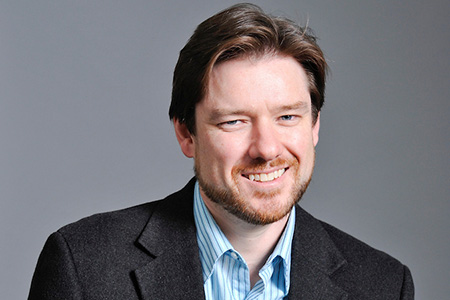Gaucher edits first virtual reality feature film

Associate Professor Daniel Gaucher of Visual and Media Arts is the editor of what is believed to be the first virtual reality feature film.
Associate Professor Daniel Gaucher is the editor behind what is believed to be the first virtual reality feature film, which is being distributed by Samsung’s virtual reality platform, Milk VR, on Wednesday, September 9.
“It was amazing,” said Gaucher, of the Visual and Media Arts Department. “We worked directly with Samsung, which hadn’t seen anything like this before.”
What separates the film Gaucher worked on, titled MansLaughter, with other virtual reality works is that there is a plot and story structure.
“It’s brand new. Nobody has done what we did,” Gaucher said. “It’s amazing to see the people coming out of the woodwork [from the film industry] who are interested in this.”
Unlike a traditional movie, MansLaughter is split into four sections that play simultaneously. The movie-watcher, who wears goggles, can look at any of the four scenes to experience the story, which, in the case of MansLaughter, is about coworkers who plan and carry out their boss’s murder during a concert.
“You put the goggles on and it uses your head positioning to turn you around in the environment,” said Gaucher, who said the goggle device is called Gear VR and is produced by Samsung and Oculus. “As you’re turning, you’re hearing what you’re looking at.”
Gaucher said he experienced “a bit of a technical learning curve” while editing the film, which is a PhD project by students at the University of Texas at Dallas.
“You’re talking about ripping up 100 years of editing language,” he said. “It’s all changing. A lot of things have to be tried from scratch.”
Watching MansLaughter in virtual reality takes about 14 minutes, which is short for a feature film, but Gaucher points out that there are 55 minutes of material. Because the material is separated into four sections and “stacked” on each other, the experience of watching the film takes only 14 minutes.
As the number of people streaming movies and TV shows on their smartphones continues to soar, Samsung and other media companies are looking closely into virtual reality technology—and ways to plug virtual reality tools, such as Gear VR, into people’s smartphones.
Gaucher, who continues to teach and work as an editor for broadcast TV shows, including NOVA on PBS, sees endless possibilities for virtual reality films.
“Picture yourself experiencing this movie,” he said. “There are people talking all around you. Suddenly a loud noise comes at you and you turn around, or something rushes at you. It’s like being stuck in a movie you can’t escape from. It’s so immersive and it’s going to be amazing.”
Gaucher said he is currently working with two Emerson graduate students on virtual reality films.
“It’s just realizing its potential,” he said. “[MansLaughter] is not a blockbuster film, but it’s definitely starting to push a new medium to see where it’s going. To be a part of that original push is a great feeling.”
Categories